

|
Soundclip:
|
| See Steve's Hand-Written Lead Sheet |
|
Steve Khan's Lead Sheet for: "Lalela Kahle"(Listen Up!)(Bakithi Kumalo-Steve Khan-Robbi Kumalo) I suppose that I first heard about South African bassist Bakithi Kumalo when Paul Simon's "GRACELAND"(Columbia) album took the USA by storm in 1986. I don't think that I actually had the privilege of meeting Bakithi until many, many years later. I never would have anticipated that he and I would end-up working closely together and creating, co-writing two interesting pieces of music for what was to become his first album as a leader, "SAN BONAN"(SIAM), released in 1998. 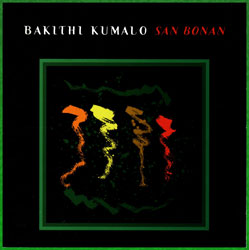 Virtually all of the work that I did for and with Bakithi was done during the calendar year of 1997. I just spent some time with my reliable datebooks from those years and researched when various events took place. It was fascinating looking back at that period of my life. I had just recorded "GOT MY MENTAL"(Evidence) in 1996, and Rob Mounsey and I had begun our second collaboration that resulted in one of my favorite albums, "YOU ARE HERE"(SIAM). I was some 3 years past my divorce, though still having a difficult time of it - that I recall very well. Virtually all of the work that I did for and with Bakithi was done during the calendar year of 1997. I just spent some time with my reliable datebooks from those years and researched when various events took place. It was fascinating looking back at that period of my life. I had just recorded "GOT MY MENTAL"(Evidence) in 1996, and Rob Mounsey and I had begun our second collaboration that resulted in one of my favorite albums, "YOU ARE HERE"(SIAM). I was some 3 years past my divorce, though still having a difficult time of it - that I recall very well.As it so often does, working with Bakithi began with a phone call - and it came from then GRP Records staff engineer and head of post-production duties for the label, Mike Landy. Like so many people in the music business, Mike had many dreams, bigger dreams, and sought to produce and perhaps, someday, have his own label - benefitting from his experience with the immense success of GRP. My memory is a bit hazy where the exact chronology is concerned, but I believe that Mike first contacted me to see if I wanted to play some guitar on a couple of the tunes for Bakithi Kumalo's album. I ended-up playing on and enjoying both "Makhaya" & "Zululand" and I especially liked "Makhaya" - written for a dear friend of Bakithi's. I imagine that, in conversations between Bakithi and Mike Landy afterwards, they liked what I had done, and Mike approached me to see if I had any tunes that I thought would be good for Bakithi and his album. 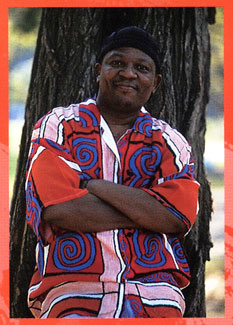 As it turned out, I had been working on two particular pieces of music, very keyboard oriented - and they represented the further explorations of my then ongoing study and love for the harmonies of Clare Fischer. As it turned out, I had been working on two particular pieces of music, very keyboard oriented - and they represented the further explorations of my then ongoing study and love for the harmonies of Clare Fischer.Relative to Bakithi's album, what became known as "Lalela Kahle"(Listen Up!) was the 1st tune that I worked on and presented to Mike and Bakithi. After I had sent Clare Fischer a fan letter in the early '90s, by some miracle, he and I became friends and began corresponding and occasionally speaking by phone. All the while, I was studying the lead sheets for many of his tunes to better understand his harmonies and to see if it was remotely possible that any of these sonorities could be executed on the guitar. There is one particular wide-voiced sonority that appears on his composition entitled, "Huracán" which appeared on a live album by Cal Tjader. The sonority I am speaking of happens in bar 4 on the and-of-2, but it is gone so quickly that it can feel more like an effect than the gorgeous color that it is. So, extracting that voicing and personalizing it - I wanted to see how if could function if it was more sustained and carried over longer. So, in letter [A] you hear this voicing in bar 1, and then it is answered by a voicing of my own creation in bar 3. This then became the basis of where Bakithi and his then wife, Robbi, created the lyric content - which, to this day, is still utterly fantastic and other worldly - as it should be. Another huge influence on me during the '90s was all of the Salsa that I was hearing by going to all of the great clubs here in Manhattan. Chief amongst them was The Latin Quarter, which was only a few blocks from where I lived. In addition to hearing all of the great soneros and their orquestas, I would always carry around a little notepad and pencil so that I could write down the names of any tunes that I heard the DJ playing in between sets. I was never too ashamed or shy to go up and ask anyone nearby what the name of that tune was, and who was the artist. This applied to the newer Salsa and, of course, the classic music from the great Fania years. One of my favorites was the 1994 Sergio George produced, "Yay Boy" by Africando featuring the unmistakable voice of Senegal's Pape Seck, and a wicked tumbao supplied by Salsa stalwarts: Johnny Torres(Bass), Papo Pepin(Conga), Bobby Allende(Bongó), and "Chino" Nuñez(Timbal). Needless to say, the mixing of cultures and musical elements was hardly anything new. In truth, where music and art are concerned - anything and everything goes. What is possible is endless! Of course, this entire piece was created by my writing it at my trusty old Yamaha DX-7, carefully notating the voicings, and then writing out a bass part too. I don't recall how long it took me to sequence these sections with my remedial keyboard skills - but, lucky for me, Mike Landy could slow things down, and I could perform them without too much technological help - like quantizing every single thing! I think that once we had entered-in the basic sections, then it was about structuring the piece as a whole, adding in some breaks, and a few other little touches to keep it from being too monotonous. As I did then, and still do today, I mainly programmed in a kick drum and a foot-closed hi-hat. The only other orchestral part that I added in was some pizzicato strings playing upbeats, beginning on the and-of-3 of bar 1 of the [B] and [C] sections. They then reappear at bar 17 of the [Fade] which I might have labeled back then as [A4]. I have to apologize for the fact that many of the section markers, the letters, got clipped off when I first made photocopies of all of theses pages. 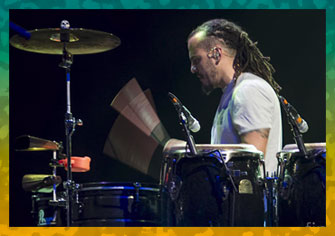 But having just now followed along with everything as the track played, the lead sheet is pretty accurate though a couple of the sections are twice as long as written. So, pay attention and take note of those details. But having just now followed along with everything as the track played, the lead sheet is pretty accurate though a couple of the sections are twice as long as written. So, pay attention and take note of those details.It wasn't all that long thereafter that we were ready to add in a most important musician and ingredient to everything that I was hoping to create and culturally merge for this project, and really everything that I had been doing since Eyewitness back in 1981. For that, I needed the presence and superb musicianship, groove and knowledge of all things Latin music, the great, great timbalero and percussionist, Marc Quiñones. Marc and I had already done a couple of significant projects together. and I just knew, I felt in my soul, that he and I were embarking on a journey that would see us recording together many times. And, lucky for me, this came true! Working together with Marc has been one of the most fruitful collaborations in my music life. So, it goes without saying, that Marc came in to the GRP Studios on April 19th, 1997 and recorded conga, timbal, and güiro on both "Lalela Kahle" and "Masala." He is spectacular on both tunes, but here, we are only addressing the former of the two. He brings together all of the cross-cultural elements that I was hoping that we could merge for this piece of music. I still enjoy listening to it to this day. It is now some 22+ years ago and it feels as though it could have been done yesterday - at least to me. I'm going to have to speak with Marc about this, but it sounds to me like he was playing a kind of a half-time Cha-cha-cha. I still get goosebumps hearing his signature avanicos everywhere. They are positively magical, and just too damn funky for words. I can't believe that I forgot to mention what really should be considered as the "bridge" in this tune, and that is letter [D] and [D2]. Fundamentally if we were trying to define a harmonic area for this piece, given the complexities of the harmonies, most of the tune would fall into an area of everything that you can do with Ebm7(sus). But that can also include moments that touch upon Ebm9(maj7), and even Ab7(9b5)/Eb. Letter [C] seems to gravitate towards Abm9/Eb at times, and also offers a huge change in dynamics from Marc Quiñones in an effort to color the vocal "hook" of the song, while getting away from the cha-cha bell to using his Jam block. It's just the perfect touch. When we do arrive at the [D] sections, there is a nice harmonic surprise as we move to D7(9sus) and sometimes D7(13b5). After so many minor colors, it's nice to be in a more dominant 7th area. The more I listen after all of these years, the more I realize that this was, in fact, a most complex piece of music on so many levels, and various touches in harmony and rhythm are easy to pass by unnoticed because of the flow of the piece and all of the colors that are used in its presentation. As I began to listen to the cassettes [Yes, that's how long ago this was!!!] of the progress that this tune was making, I began to hear other elements that would fit on top. The first of those elements was that I clearly heard that, if Mike Landy could afford to do it, I would love to have a muted trumpet and a bass clarinet, à la Miles Davis and Benny Maupin, playing certain melodic phrases underscoring what would become Bakithi's main vocal melodies. 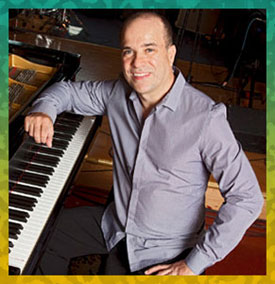 When I was given the go ahead for this, I knew that I could ask both saxophonist/multi-reed man Bob Franceschini and trumpeter Barry Danielian and they would both be fantastic at recreating such a sound. When we eventually recorded these parts on May 21st, we had so much fun because they immediately got into character, and did all the appropriate Salvador Dalí manipulations of the time feel to be behind the beat in the most perfect way. What they gave to this piece is really priceless. But there was still one touch missing for me, and that would be the inclusion of a small horn section to give the piece a kind of punch and also to further the connection to the sounds of great Latin dance music and Latin Jazz. And so, on bended knee I asked Mike Landy if we could have my great friend and mentor, to this day, the brilliant pianist/arranger Oscar Hernández write a horn chart for this piece. As Oscar lived outside of Manhattan, we had to discuss all of this via phone, and some small details, chordal sonorities that I wanted, had to wait until the day of the actual session. As I had anticipated and expected, what Oscar came in with on that particular Wednesday, as we gathered @ Unique Recording with engineer Malcolm Pollack behind the console, and additional horns: Ozzie Melendez(Trombone) and Pablo Calogero(Baritone Sax) was just so perfect for the mood and attitude that I wanted to convey - along with a sense of mystery and romance. Suddenly, it was all there. When I was given the go ahead for this, I knew that I could ask both saxophonist/multi-reed man Bob Franceschini and trumpeter Barry Danielian and they would both be fantastic at recreating such a sound. When we eventually recorded these parts on May 21st, we had so much fun because they immediately got into character, and did all the appropriate Salvador Dalí manipulations of the time feel to be behind the beat in the most perfect way. What they gave to this piece is really priceless. But there was still one touch missing for me, and that would be the inclusion of a small horn section to give the piece a kind of punch and also to further the connection to the sounds of great Latin dance music and Latin Jazz. And so, on bended knee I asked Mike Landy if we could have my great friend and mentor, to this day, the brilliant pianist/arranger Oscar Hernández write a horn chart for this piece. As Oscar lived outside of Manhattan, we had to discuss all of this via phone, and some small details, chordal sonorities that I wanted, had to wait until the day of the actual session. As I had anticipated and expected, what Oscar came in with on that particular Wednesday, as we gathered @ Unique Recording with engineer Malcolm Pollack behind the console, and additional horns: Ozzie Melendez(Trombone) and Pablo Calogero(Baritone Sax) was just so perfect for the mood and attitude that I wanted to convey - along with a sense of mystery and romance. Suddenly, it was all there.Below, you can follow through with a view of just how a project like this, put together in various pieces could and did span in essence a full year to arrive at its completion. Well, at least completing the work on these two tunes. [January 18th] - Recording guitar for Bakithi @ GRP Studio on "Makhaya"; "Ulwandle" & "Zululand" [February-March] - Keyboard Sequencing @ GRP w/ Mike Landy [April 4th] - Transfer Keyboard Sequence to Tape [April 19th] - Marc Quiñones records conga, timbal & güiro [May 21st] - Horn Section w/ Oscar Hernández(Arr.), Barry Danielian, Bob Franceschini, Ozzie Melendez & Pablo Calogero @ Unique Recording - Malcolm Pollack: Engineer [July 22nd] - Keyboard Sequencing @ GRP Studio w/ Mike Landy [July 29th] - Keyboard Sequencing @ GRP Studio w/ Mike Landy [October 6th] - Keyboard Sequencing @ GRP Studio w/ Mike Landy [October 16th] - Bakithi records his vocals @ GRP Studio [October 20th] - Background vocals for "Masala" @ GRP Studio [October 25th] - Meeting w/ Bob Franceschini - "Masala" Horn Arrangement [October 27th] - Horn Section w/ Bob Franceschini(Arr.), Barry Danielian & Noah Bless @ Unique Recording - Malcolm Pollack: Engineer [November 13th] - Bakithi records his bass @ GRP Studio [November 15th] - Mixing "Masala" & "Lalela Kahle" @ GRP Studio w/ Mike Landy From looking over the chronology of dates and sessions, at least by my own hand, it seems that Bakithi did not actually sing his vocals on both tunes until October 16th. But, as here, we are only speaking about "Lalela Kahle," I would want to share with you that most of what I did with Bakithi, in terms of 'coaching' his performance on this tune was just to get him to use his fantastic speaking voice to say a few little phrases of encouragement in his own language. In the end, he did really great at it. Listening now, because the lead vocal is really a group vocal, a coro, I believe that Bakithi, Robbi, along with Paulette McWilliams and Armstead Christian did their vocals when I was not around. 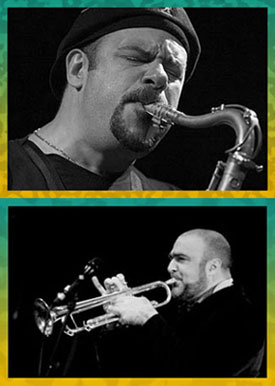 They all did a great, great job!!! They all did a great, great job!!!In another most striking development, the last thing that was recorded on this tune was, believe it or not. Bakithi's bass parts!!! How about that? Because I had carefully written out the parts in a very Latin style, it was really important that Bakithi play them that way - and if there was a way to incorporate his own personal style within those boundaries, it would have been fine with me. But, listening to the final version now, and looking at the part, it seems that Bakithi honored my request and was most faithful to the written music. In the end, I still feel that that was the best thing for the overall success of the arrangement and the piece. Now, you, the listener will have to be the judge of that. The [Fade] of this piece was intended to be hypnotic more than anything else. Even if people could not understand the repeated lyrics, they could certainly try to sing along phonetically. With that in mind, as the piece is fading, you have various elements new and old entering the arrangement. The Fade begins at about 4:47, I wish that I could write out for you the actual lyrics here - but, to these completely uneducated ears, it always sounded like something between: "Z-Z Top, Top, Top - tay gahsh-way | Oba nee, nee, nee - yah bahn-tu." Of course, it could also be: "Easy Pop, Pop, Pop - tay gahsh-way | Oba nee, nee, nee - yah bahn-tu." Sing along that way, and see what you sound like! Go for it!!! When the horns were recording that day in May, I remember that I sang/dictated to Ozzie and Pablo a repeated 4-bar refrain that would be played all the way out. After 8 bars of that, "Miles and Benny" (Barry and Bob) re-enter with a paraphrase of their main theme all the way out. At about 5:30, you can hear Marc Quiñones pick-up the intensity with some great fills and ad-lib crashes, plus one final killer avanico. What can I say? I just love listening to this Fade. I hope that you will too. And don't forget, all of this is going on with the comforting yet mysterious sonorities influenced by Clare Fischer! I wanted to share with everyone what Bakithi wrote about this particular song in the CD booklet. He said the following: "Musical collaboration is very interesting. You take different people, with different perspectives and cultures, put them together, and you get surprising outcomes. This is true for this song - a great learning experience. When you listen carefully, music is truly a song for the heart that is free." When one embarks down the road of a collaborative project such as this, through all the ups and downs, the end result is really the only thing that matters. I remain ever so grateful to both Mike Landy and Bakithi Kumalo for their faith in me - and for allowing me the freedom to follow my own particular muse in order to produce a result that, in the end, would be the best for Bakithi and his album - and give his many fans a chance to hear most unique fusion of elements, genres and cultures coming together in a once-in-a-lifetime way. One thing that I do want to address here is the obvious fact that nowhere did I play any guitar on this tune! You might be wondering, "Steve, why is that?" Well, it's pretty simple. At that time, I just didn't hear anything, the thought never entered my mind - so I left things as you now hear them. When I listen now, nothing feels like it's 'missing' to me. Yes, I suppose that I could have invented something, on this tune, given the texture and air of mystery, if I did something I would choose my Martin MC-28 steel-string acoustic, because that sound would separate itself from everything else, while perhaps adding an earthiness to the song. Sitting here now, I am happy to let this piece of music stand as it is. It remains a most bitter and sad, sad irony that about 2 weeks after both "SAN BONAN" and "YOU ARE HERE" were released on Mike Landy's SIAM Records, the company had to go out of business - leaving both albums flying on the winds of cruel fate - and, in essence, lost forever. To this day, it makes me so sad I can barely speak about it. To have worked that hard on two projects and to see them gone in an instant. It was really crushing. I'm sorry for ending on such a note - but, it is also a part of this story!
[Photos: Bakithi Kumalo - Photo by: Guy Keren
Marc Quiñones Oscar Hernández Bob Franceschini-Barry Danielian Collage] |